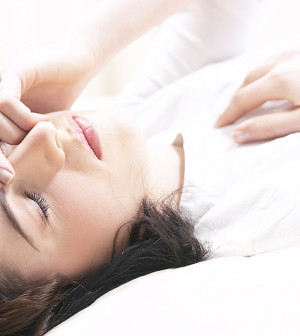- Navigating Your Midlife Crisis: Embracing New Possibilities
- City Raccoons Showing Signs of Domestication
- Mapping the Exposome: Science Broadens Focus to Environmental Disease Triggers
- One Week Less on Social Media Linked to Better Mental Health
- Your Brain Changes in Stages as You Age, Study Finds
- Some Suicide Victims Show No Typical Warning Signs, Study Finds
- ByHeart Formula Faces Lawsuits After Babies Sickened With Botulism
- Switch to Vegan Diet Could Cut Your Greenhouse Gas Emissions in Half
- Regular Bedtime Does Wonders for Blood Pressure
- Dining Alone Could Mean Worse Nutrition for Seniors
Giving the ‘Green Light’ to Migraine Relief

A new study sheds light — literally — on a potential means of easing migraine pain.
Researchers in Boston exposed 69 migraine patients to different colors of light. They found that while blue light exacerbated headache pain, a narrow spectrum of low-intensity green light significantly reduced light sensitivity.
In some cases, this green light also reduced migraine pain by about 20 percent, the researchers found.
They noted that migraine headache affects nearly 15 percent of people worldwide, and a frequent symptom of migraine is light sensitivity, also known as photophobia.
“Although photophobia is not usually as incapacitating as headache pain itself, the inability to endure light can be disabling,” study author Rami Burstein, of Beth Israel Deaconess Medical Center in Boston, said in a medical center news release.
“More than 80 percent of migraine attacks are associated with and exacerbated by light sensitivity, leading many migraine sufferers to seek the comfort of darkness and isolate themselves from work, family and everyday activities,” he added. Burstein directs the medical center’s Comprehensive Headache Center.
Two experts said the treatment may have merit.
“Certainly Dr. Burstein’s work suggests that more research should be done, as this is a potentially beneficial new avenue for treatment,” said Dr. Noah Rosen, who directs Northwell Health’s Headache Center in Great Neck, N.Y.
He pointed out that “light therapy has been used successfully in other conditions such as certain dermatologic issues and seasonal affective disorder [SAD].”
Dr. Gayatri Devi is a neurologist at Lenox Hill Hospital in New York City.
He said the success in some patients with light therapy “implicates the thalamus — a brain ‘relay station’ between the sensory organs, including the eyes and the cortex of the brain — as the area where migraine-related photophobia is amplified.”
For his part, Burstein said he’s now trying to develop an affordable light bulb that emits narrow-band green light at low intensity, as well as sunglasses that block all but the narrow band of green light.
Rosen stressed, however, that more study may still be needed.
“In general, it seems a safe treatment but one that is limited by cost, access and whether its use on a regular basis would decrease disability,” he said.
The findings were published May 17 in the journal Brain.
More information
The American Academy of Family Physicians has more about migraines.
Source: HealthDay
Copyright © 2025 HealthDay. All rights reserved.










